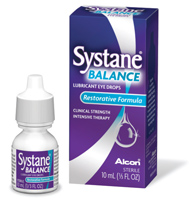• The CIBA Vision Academy for Eyecare Excellence has added 16 new online learning modules to its professional education programs at www.cibavisionacademy.com/us. The modules cover basic to advanced topics on a variety of topics ranging from multifocal soft lens fitting to ocular anatomy. The 40-minute modules are specialized for eye care practitioners or staff members and end with an online test. Scores are immediately calculated, and users can print out a certificate of completion.
• TearLab Corporation announced a $24.01 per eye reimbursement from the Committee for Medicare and Medicaid Services (CMS) for the TearLab Osmolarity test, effective January 2011. Reimbursement by CMS will only be available for offices that have a Moderate Complex CLIA certificate until TearLab receives a CLIA Waiver categorization from the FDA. This reimbursement is part of the recommended payment determination for new test codes. The complete Current Procedural Terminology code will be published by the American Medical Association in December 2010.
• A new clinical study recently published in the Sept. 10 issue of Eye suggests that the use of contact lenses is an important risk factor for pinguecula. Researchers worked to assess the relationship between age, incidence and severity of pinguecula in 600 lens wearers and to compare the grade of pinguecula between lens wearers and non-wearers. Results suggest an age-related increase in the grade of pinguecula among lens wearers and non-wearers. The grade of pinguecula at the temporal conjunctiva was higher in lens wearers than in non-wearers, whereas it was higher in rigid lens wearers than soft lens wearers at both the nasal and temporal conjunctiva.
American Eye-Q Releases Survey Results
According to the American Optometric Association’s (AOA) fifth annual survey, many contact lens wearers are breaking the rules and putting their health and vision at risk by doing so.
• Only 25% respondents replace their daily disposable lenses everyday, while a vast majority admit to wearing their disposable lenses longer.
• About 25% of respondents wear contact lenses while sleeping.
• About 58% of contact lens wearers clean and disinfect lenses with the appropriate solution, 23% soak or clean lenses in water and 12% store contacts in something other than a typical storage case.
The AOA also raised concerns about kids and contact lenses, cautioning the importance of considering children’s level of responsibility and social interaction prior to introducing them to soft contact lenses. Over 50% of eye care practitioners believe a child can be introduced to contact lenses at 10-12 years of age.
Finally, the AOA cited concern for the recent popularity of circle-tinted lenses: lenses designed to make the eye’s iris appear larger. Improper use of these often non-FDA-approved lenses can result in blurred or fuzzy vision, red or irritated eyes, uncomfortable lenses, pain in and around the eye and even cornea inflammation or keratitis. For more information, visit www.aoa.org.
Optometry Named a Top Career Choice
Money Magazine and Payscale.com have named optometry as one of the top 100 professions of 2010. With a median pay of $108,000 and a top pay as high as $163,000, optometrists have been named the 20th highest paying job in the country. Taking into consideration high pay, job growth and quality of life, optometrists were ranked 56th on the Best Jobs in America list and 10th in the Least Stressful Jobs category. Optometrists themselves say the field is all about options: choosing to join a group or open a solo practice; venturing into academia and the freedom of setting their own schedule.
Rebate Program
An enhanced additional rebate program from VSP Vision Care and Vistakon began Oct. 1, 2010. Members who purchase an annual supply of Acuvue contact lenses from one of VSP’s 27,000 network providers will receive an additional $25 rebate on top of the currently offered national rebate program. For more information, please visit
www.vsp.com.
 New Drops for MGD patients
New Drops for MGD patients
Alcon is launching Systane Balance Lubricant Eye Drops designed for patients with Meibomian Gland Dysfunction (MGD) who suffer from dry eye symptoms from failure to prevent the evaporation of tears. Systane Balance is a scientifically engineered product that contains HP Guar, borate, sorbitol, propylene glycol and Alcon’s LipiTech system. It is designed to restore the lipid layer and the natural tear film to allow for relief of dry eye symptoms. Systane Balance is available without prescription at major retailers across the United States. For more information on the Systane Balance products, please visit
www.systane.com.
A Lens Enhancement
Vistakon’s Acuvue Advance Plus contact lens with Hydraclear Technology will replace the company’s Acuvue Advance lens. Acuvue Advance Plus is available in base curves of 8.3mm and 8.7mm, with parameters ranging from -0.50D to -6.00D and +0.50D to +6.0D in 0.25D increments and from -6.50D to 12.0D and +6.50D to +8.0D in 0.50D increments. Its Hydraclear Technology combines high performance base materials with a moisture-rich wetting agent, which contributes to improvements in initial and overall comfort, as well as visual clarity, the company says.
Perceived vs. Actual Compliance
In a recent study conducted at the Optometry Clinic at the University of Texas Southwestern Medical Center in Dallas, Tex., patients were accessed on their level of compliance regarding lens care practices. Of the 162 total patients, 86% believed they were compliant with lens wear and care practices, while 14% identified themselves as noncompliant. Using a scoring model, 32% of patients were found to demonstrate good compliance, 44% showed average compliance and 24% were noncompliant. Although 80% of patients were aware of the risk factors, awareness did not influence negative behavior; replacing the lens case was the only learned behavior modification.1
The study concluded that education alone would not improve risky behavior, as a significant portion of contact lens wearers are aware of the risks associated with poor use but continue to remain noncompliant in their care.
1. Bui TH, Cavanagh HD, Robertson DM. Patient compliance during contact lens wear: perceptions, awareness and behavior. Eye Contact Lens. 2010 Oct. [epub ahead of print].


